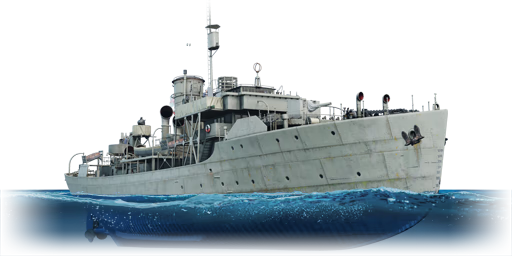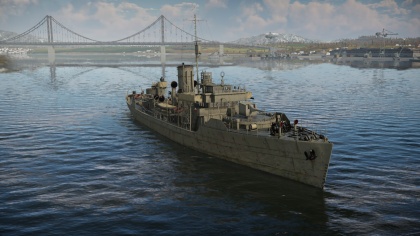HMCS Brantford
Contents
Description
The Flower-class, HMCS Brantford (K-218) is a rank British sub-chaser
with a battle rating of (AB), (RB), and (SB). It was introduced in Update 1.83 "Masters of the Sea" as part of the British fleet Closed Beta Test.
General info
Survivability and armour
Talk about the vehicle's armour. Note the most well-defended and most vulnerable zones, e.g. the ammo magazine. Evaluate the composition of components and assemblies responsible for movement and manoeuvrability. Evaluate the survivability of the primary and secondary armaments separately. Don't forget to mention the size of the crew, which plays an important role in fleet mechanics. Save tips on preserving survivability for the "Usage in battles" section. If necessary, use a graphical template to show the most well-protected or most vulnerable points in the armour.
Mobility
Write about the ship's mobility. Evaluate its power and manoeuvrability, rudder rerouting speed, stopping speed at full tilt, with its maximum forward and reverse speed.
Armament
Primary armament
Provide information about the characteristics of the primary armament. Evaluate their efficacy in battle based on their reload speed, ballistics and the capacity of their shells. Add a link to the main article about the weapon: {{main|Weapon name (calibre)}}. Broadly describe the ammunition available for the primary armament, and provide recommendations on how to use it and which ammunition to choose.
Secondary armament
Some ships are fitted with weapons of various calibres. Secondary armaments are defined as weapons chosen with the control Select secondary weapon. Evaluate the secondary armaments and give advice on how to use them. Describe the ammunition available for the secondary armament. Provide recommendations on how to use them and which ammunition to choose. Remember that any anti-air armament, even heavy calibre weapons, belong in the next section. If there is no secondary armament, remove this section.
Anti-aircraft armament
An important part of the ship's armament responsible for air defence. Anti-aircraft armament is defined by the weapon chosen with the control Select anti-aircraft weapons. Talk about the ship's anti-air cannons and machine guns, the number of guns and their positions, their effective range, and about their overall effectiveness – including against surface targets. If there are no anti-aircraft armaments, remove this section.
Special armament
Depth charges, mines, rocket launchers and missiles are also effective in skilled hands and can take an off-guard opponent by surprise. Evaluate the ammunition of this type of armament and rate its performance in combat. If there are no special armaments, remove this section.
Usage in battles
Describe the technique of using this ship, the characteristics of her use in a team and tips on strategy. Abstain from writing an entire guide – don't try to provide a single point of view, but give the reader food for thought. Talk about the most dangerous opponents for this vehicle and provide recommendations on fighting them. If necessary, note the specifics of playing with this vehicle in various modes (AB, RB, SB).
Pros and cons
Summarise and briefly evaluate the vehicle in terms of its characteristics and combat effectiveness. Mark its pros and cons in the bulleted list. Try not to use more than 6 points for each of the characteristics. Avoid using categorical definitions such as "bad", "good" and the like - use substitutions with softer forms such as "inadequate" and "effective".
Pros:
Cons:
History
Just prior to WW2, it became apparent that German U-boats would present a serious threat to British transatlantic shipping in the event of an outbreak of hostilities. Realizing this, it became clear to the Royal Navy that they needed a large number of new small vessels that could cope with this threat, whilst being cheap, simple and quick to produce, without hindering the construction of larger warships.
In response to the demand, the Smiths Dock Company proposed a modified version of one of their 700-ton whale catchers. The proposed ship virtually met all Royal Navy requirements and could even be built by smaller shipyards across the country, meaning that a large-scale production wouldn’t affect the construction of larger warships. The proposed design was accepted and the first orders for Flower-class corvettes came in as early as July 1939.
Although initially only intended to operate along the British coast line, the large range and robust seaworthiness of the Flower-class corvettes soon saw ships of this class escorting Atlantic convoys to and from Great Britain. Their primary role was to fend off submarines, which is why ships of this class were relatively lightly armed and often specialized in anti-submarine warfare.
Apart from Great Britain, Flower-class corvettes were used extensively in various different roles by numerous other nations during WW2, including the United States, France, Canada, Greece, the Netherlands and many more. Ships of this class served right up until the end of WW2, even when more advanced designs began to replace them.
Whilst Spitfires and Hurricanes kept the Luftwaffe out of British skies, the venerable Flower-class corvettes ensured that vital supplies reached Great Britain, by fighting off the German submarine wolf-packs throughout the war. With over 260 ships built, the Flower-class corvette remains one of Britain’s most mass-produced wartime ship type, whose contribution to the war effort is highly obvious.
- From Devblog
Media
Excellent additions to the article would be video guides, screenshots from the game, and photos.
See also
Links to articles on the War Thunder Wiki that you think will be useful for the reader, for example:
- reference to the series of the ship;
- links to approximate analogues of other nations and research trees.
External links
| Britain sub-chasers | |
|---|---|





